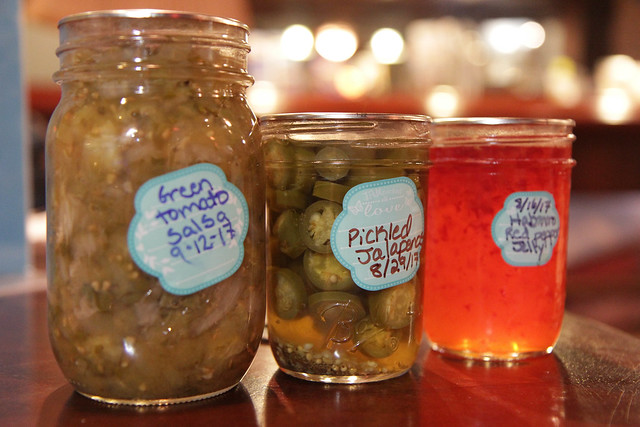My latest column in the Charleston Gazette-Mail:
Local food takes on a different meaning for some folks during the cool winter months. It’s no longer a fresh bounty of bright red tomatoes gathered along a vine in the garden or a blooming bundle of green lettuce from next door.
While local farms can extend the growing season with the help of high tunnels and greenhouses, some folks in rural areas have their own way of preserving food: canning and pickling (and drying, fermenting, etc.).
Opening up a Ball jar full of green beans on a cold December evening can feel like adding a fresh taste of summer to your plate. These methods of preservation are prevalent across the country — and world — but even after home canning fell out of favor in urban areas as food production became more industrialized, canning has persisted across the Appalachian region where mountainous winters can be harsh and savoring homegrown veggies is cost-effective.
Connection to place
My sweet grandmother, born in 1942, cans her garden vegetables every summer because it’s cheaper than buying from the grocery store — and tastes better. She supplements meals with fresh vegetables from local farmers, but I fondly remember her working away in the kitchen to line shelves with glass jars full of her garden-fresh harvest.
One summer, she said she canned 75 quarts.
“I can the tomatoes and the green beans so we can put them up and eat them throughout the year whenever we want,” she told me, using one of my favorite phrases of “putting up” — or storing.
She uses a pressure cooker to can everything from tomatoes and green beans to peaches and venison (she emphasized the need for a bouillon cube for that one).
“If you raise a big garden,” she said, “you can put up just about anything, and it can last for years if you do it right.”
The pressure cooker is one way to can, but even without one, it’s fairly simple: Fill a jar with food, put the flat lid and threaded ring on top of the jar, and submerge the whole jar under boiling water (time varies). Once the jar is lifted from the water, the heat rushes out of the jar, along with any air left inside. That pulls the lid down, suctioning it to an airtight seal.
History
Canning actually goes back for centuries, according to Serious Eats. In the 1700s, Napoleon Bonaparte offered a cash prize to the person who could create a way to preserve food for his troops. Nicolas Appert, a French cook, created the packing, heating and sealing method used today.
Home canning became popular in America in the late 1850s, when John L. Mason created the first reusable jar with a screw-on lid. In 1915, Alexander H. Kerr invented the two-part canning lid used today.
While my grandmother cans partially due to frugality and partially due to tradition, many others today practice the art of canning for hobby.
Liana Krissoff, author of “Canning for a New Generation: Updated and Expanded Edition: Bold, Fresh Flavors for the Modern Pantry,” had this to say about canning:
“Traditionally, of course, canning and other, much older forms of preserving — drying, salting, fermenting, stashing vegetables in the root cellar, and so on — were essential ways of ensuring you’d have food through the winter. Now that refrigeration is pretty much universal, I think canning for most people is less a necessity than a lifestyle choice.
“People who have gotten into canning and preserving in the last five or 10 years, for the most part, are doing it because they want to, because it’s a fun and productive way to spend time in the kitchen, not because they have to.
“It’s an effective, easy way to preserve produce when it’s at its best, and I think to a lot of people it’s important that they know exactly what is going into their foods. If they’ve bought a box of tomatoes at a farmers market or picked them from their own gardens and canned them in glass jars with nothing more than a little citric acid or lemon juice to up the acidity a bit, they know what they’re getting and they know it’s a healthful, safe ingredient to use throughout the year.”
Additional preservation methods
Pickling is a method of preservation that involves using a brine to ferment food then storing it in vinegar.
According to Mark Sohn in “Appalachian Home Cooking: History, Culture and Recipes,” pickling has always been especially popular in rural areas, and mountaineers in particular enjoyed sauerkraut, pickled beets, corn relish, dilly beans and chow chow.
Chow chow is a relish that was likely introduced to the country by Chinese railroad workers in the 1850s.
“The odd mixture of fall garden produce became popular among mountain families, and it has remained a favorite,” Sohn writes. “Today, those who travel find chow chow sold up and down the Appalachian Mountains, but less frequently to the east or west.”
Traditions like these run strong within my family and ties me to the place I’m from. My grandma’s connection to her garden that we enjoyed throughout the year is a fond memory I will always treasure. Pickled veggies always make it to appetizer trays during holiday meals. And no beans and cornbread is complete without chow chow.
Being able to enjoy vegetables from the garden year-round thanks to a tradition my family has practiced for generations forms a stronger bond with Appalachia. And there’s just nothing like a little taste of summer on a cold December evening.
Local food takes on a different meaning for some folks during the cool winter months. It’s no longer a fresh bounty of bright red tomatoes gathered along a vine in the garden or a blooming bundle of green lettuce from next door.
While local farms can extend the growing season with the help of high tunnels and greenhouses, some folks in rural areas have their own way of preserving food: canning and pickling (and drying, fermenting, etc.).
Opening up a Ball jar full of green beans on a cold December evening can feel like adding a fresh taste of summer to your plate. These methods of preservation are prevalent across the country — and world — but even after home canning fell out of favor in urban areas as food production became more industrialized, canning has persisted across the Appalachian region where mountainous winters can be harsh and savoring homegrown veggies is cost-effective.
Connection to place
My sweet grandmother, born in 1942, cans her garden vegetables every summer because it’s cheaper than buying from the grocery store — and tastes better. She supplements meals with fresh vegetables from local farmers, but I fondly remember her working away in the kitchen to line shelves with glass jars full of her garden-fresh harvest.
One summer, she said she canned 75 quarts.
“I can the tomatoes and the green beans so we can put them up and eat them throughout the year whenever we want,” she told me, using one of my favorite phrases of “putting up” — or storing.
She uses a pressure cooker to can everything from tomatoes and green beans to peaches and venison (she emphasized the need for a bouillon cube for that one).
“If you raise a big garden,” she said, “you can put up just about anything, and it can last for years if you do it right.”
The pressure cooker is one way to can, but even without one, it’s fairly simple: Fill a jar with food, put the flat lid and threaded ring on top of the jar, and submerge the whole jar under boiling water (time varies). Once the jar is lifted from the water, the heat rushes out of the jar, along with any air left inside. That pulls the lid down, suctioning it to an airtight seal.
History
Canning actually goes back for centuries, according to Serious Eats. In the 1700s, Napoleon Bonaparte offered a cash prize to the person who could create a way to preserve food for his troops. Nicolas Appert, a French cook, created the packing, heating and sealing method used today.
Home canning became popular in America in the late 1850s, when John L. Mason created the first reusable jar with a screw-on lid. In 1915, Alexander H. Kerr invented the two-part canning lid used today.
While my grandmother cans partially due to frugality and partially due to tradition, many others today practice the art of canning for hobby.
Liana Krissoff, author of “Canning for a New Generation: Updated and Expanded Edition: Bold, Fresh Flavors for the Modern Pantry,” had this to say about canning:
“Traditionally, of course, canning and other, much older forms of preserving — drying, salting, fermenting, stashing vegetables in the root cellar, and so on — were essential ways of ensuring you’d have food through the winter. Now that refrigeration is pretty much universal, I think canning for most people is less a necessity than a lifestyle choice.
“People who have gotten into canning and preserving in the last five or 10 years, for the most part, are doing it because they want to, because it’s a fun and productive way to spend time in the kitchen, not because they have to.
“It’s an effective, easy way to preserve produce when it’s at its best, and I think to a lot of people it’s important that they know exactly what is going into their foods. If they’ve bought a box of tomatoes at a farmers market or picked them from their own gardens and canned them in glass jars with nothing more than a little citric acid or lemon juice to up the acidity a bit, they know what they’re getting and they know it’s a healthful, safe ingredient to use throughout the year.”
Additional preservation methods
Pickling is a method of preservation that involves using a brine to ferment food then storing it in vinegar.
According to Mark Sohn in “Appalachian Home Cooking: History, Culture and Recipes,” pickling has always been especially popular in rural areas, and mountaineers in particular enjoyed sauerkraut, pickled beets, corn relish, dilly beans and chow chow.
Chow chow is a relish that was likely introduced to the country by Chinese railroad workers in the 1850s.
“The odd mixture of fall garden produce became popular among mountain families, and it has remained a favorite,” Sohn writes. “Today, those who travel find chow chow sold up and down the Appalachian Mountains, but less frequently to the east or west.”
Traditions like these run strong within my family and ties me to the place I’m from. My grandma’s connection to her garden that we enjoyed throughout the year is a fond memory I will always treasure. Pickled veggies always make it to appetizer trays during holiday meals. And no beans and cornbread is complete without chow chow.
Being able to enjoy vegetables from the garden year-round thanks to a tradition my family has practiced for generations forms a stronger bond with Appalachia. And there’s just nothing like a little taste of summer on a cold December evening.



0 comments